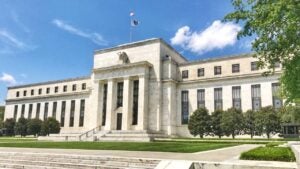Stock market outlook for 2025: How Powell, inflation and Trump’s return could affect returns

The stock market turned in another solid performance last year, making it two years in a row with strong returns for investors. The bellwether S&P 500 index rose 22.7 percent in 2024, after putting up a stellar 22.3 percent gain the year before. Will 2025 finally be the year for the market’s performance to soften?
Here are the key things to watch this year.
Experts in Bankrate’s Fourth-Quarter 2024 Market Mavens survey foresee the market moving up moderately in 2025, climbing a total of 7 percent, amid concern about fiscal and monetary policy. While many analysts acknowledge the favorable business climate, they were also concerned about the valuation of stocks, especially after their performance in the past two years.
Other potential headwinds await stocks in 2025, too. With inflation picking up in recent months and the possibility for potentially inflationary policies under a new Trump administration, analysts have dialed down their expectations for how much the Federal Reserve will cut interest rates in 2025. But those negatives still need to be balanced against an economy with momentum that’s powered through any weaknesses of late.
So even with a few watch points, the coming year still looks like it has the potential for attractive returns, even if they may not be as robust as in recent years.
Stocks in 2025: Will the bull market continue?
The fundamentals of the U.S. economy have remained solid, and that’s expected to continue in 2025. A business-friendly Trump administration will likely stoke the economy and market further, through more deficit spending and tax cuts, continuing the growth already seen under the Biden administration. Tack on the stock market’s momentum, and stocks look set to move higher.
Corporate profit growth is likely to remain strong this year as the economy as a whole continues to grow, and profit growth will provide strong upward impetus to stocks.
“We expect double-digit global earnings growth for 2025, as well as the likely broadening out of earnings and performance beyond the Magnificent 7, for example,” says Steve Larson, portfolio manager, global equities at Principal Asset Management. Larson is referring to the Magnificent 7 stocks, which have led the market higher in recent years. This group includes tech titans like Apple, Alphabet and Microsoft, as well as electric car maker Tesla.
Strong fundamentals should help stocks perform well, but they may also be helped by robust liquidity in the market and ongoing investor optimism that can boost valuations. Bullish sentiment — and the room for still higher levels of sentiment — could continue to help stocks in 2025.
“Investor sentiment is far from frothy,” says Daniel Milan, managing partner at Cornerstone Financial Services in Southfield, Michigan.
There is a cycle to bull markets. They are born in despair, mature on skepticism, bloom on optimism and finally die on euphoria.
— Daniel Milan Managing partner, Cornerstone Financial Services
Milan adds, “It’s reasonable to believe that we’ve transitioned from skepticism to cautious optimism. But the latest investor sentiment survey proves how widespread euphoria is still a long way off.”
“Sentiment and investor perception are big drivers of stock movement, so I expect the enthusiasm for a lower regulatory environment and the overall pro-business stance of the Trump administration will produce a solid to strong market in 2025,” says Rick Miller, investment advisor at Miller Investment Management in Manassas, Virginia.
Eyes on the Fed
While the actions of the Fed are not likely to be the key driver of returns this year, they will still play a significant role. With inflation still somewhat higher than the Fed’s 2 percent target and not moving away from it recently, the Fed is likely to slow its pace of lowering interest rates.
“The Federal Reserve’s cautious policy stance heading into 2025 reflects sticky inflation, resilient growth and uncertainty around the incoming administration’s policies,” says Larson.
Inflation, as measured by the Consumer Price Index, has been going in the wrong direction in the last few months, even after most of 2024 saw progress. Inflation fell to 2.4 percent in September, but climbed back to 2.7 percent in November, leading analysts to expect the Fed to slow-walk further interest rate decreases in 2025.
“Keep a close eye on inflation and whether sticky parts of inflation are going to persist, including wage inflation,” says Larson. He notes “the last mile of getting inflation under control is difficult.”
But it’s important to remember that the Fed is still poised to lower rates amid a largely robust economy, says Milan. “Fast or slow, don’t fight the Federal Reserve that’s cutting rates.”
“As we sit here today, there still is no recession in sight,” says Milan. “Gross domestic product growth remains steady, and consumer spending is maintaining its resiliency to underpin the overall economy.”
Uncertain inflation under Trump
But what the Fed does with rates may depend heavily on the policies unveiled by the incoming Trump administration. Many economists expect the as-stated policies, notably broad-based tariffs and further tax cuts, to generate significant inflation, a move that could lead the Fed to raise rates to keep inflation under control. For now, the Fed has announced that it’s taking a “wait-and-see” approach to any policy that may or may not be enacted. A significant rise in inflation could quickly shift the market’s perception of where rates are going in 2025.
“A spike in inflation would be challenging for everyone, given the negative impact on liquidity conditions,” says Larson. “While our current forecast anticipates three rate cuts next year, the path forward will depend heavily on inflation progress and labor market conditions.”
The market seems to have already begun pricing in higher inflation under Trump as well. When Trump was re-elected in early November, the market sent the benchmark 10-year Treasury yield much higher the next day and even more in subsequent weeks. Now, the widely followed rate is sitting at nearly its highest levels in the last 52 weeks.
Other market watchers see Trump’s stated policies as part of a negotiation strategy that may ultimately lead to an outcome that is better than what is feared.
“Tariffs lead to talks, which lead to deals,” says Milan. Based on the first Trump administration, “it’s reasonable to expect that any tariff bluster is likely a negotiating ploy on the way to economic policies that are milder than originally feared,” says Milan.
Keep in mind, markets don’t need risk-free conditions. Markets move on the gap between expectations and reality. So outcomes that are merely better than feared are all stocks need to rally.
— Daniel Milan Managing partner, Cornerstone Financial Services
How should investors navigate a volatile 2025?
The strong performance of stocks in the last two years may make investors more cautious about paying today’s higher prices, especially given some of the potential risks noted above. However, the overall economic climate remains strong, and there’s not a significant risk of a recession in sight. So both short-term and long-term investors may continue to find the market an attractive place to invest in 2025. Here are a few strategies for this year (and really any year).
Invest for the long term
It can be easy to lose sight of the strong long-term returns that have been available in the market for years and instead focus on the short-term risks. But the past had many of the same risks that we’re seeing today, too. Long-term investors who focused on five or 10 years out saw opportunity beyond today’s market noise and invested with that mindset.
Even if the market faces some setbacks this year, those with a long-term mindset see that as an opportunity to supercharge their returns in future years, buying now at reduced prices. This can be an especially attractive strategy if you’re investing in a time-tested index such as the S&P 500, which has returned about 10 percent annually on average over time.
Maintain discipline
After the market’s recent strong performance, it can be tough to keep your investing discipline. On the one hand, you may be tempted to pile into stocks to ride the wave higher. On the other hand, you may be tempted to sit this wave out, expecting it to crash at any moment. Either way, you want to keep your emotions out of the process and stick to making smart, long-term decisions.
For many investors, maintaining their discipline means sticking to their long-term investing plan, mostly regardless of what the market is doing today. For them, this approach may mean continuing to invest with dollar-cost averaging into proven index funds in any climate. For other investors, it may mean to continue seeking out value-priced stocks or strong growth picks. Whatever your process, it can be valuable to stick with what works for you.
Stay invested
With potentially negative news and risks on the horizon, it can be tough to stay invested. However, it’s important to remember that the market is always incorporating risks into how it’s pricing stocks. If you sold after stocks plummeted in 2022, you missed a stellar two years of returns unless you bought back in, though you may have done so at a less attractive price.
If you’re serious about building wealth over the long term, then it’s important that you stay invested even when things look tough. You’ll avoid racking up taxes on your gains that slow your wealth-building. Plus, if you trade in and out of the market, you’re not likely to earn the attractive long-term gains on S&P 500 index funds (again, about 10 percent per year). Research shows that passive investing beats active investing.
Staying invested is also about making sure you’re not forced out of the market when the going gets rough. For instance, having an emergency fund helps ensure that you don’t need to tap your investments when they’re at a low point, preventing you from enjoying a rebound later.
Bottom line
While 2025 may or may not deliver strong returns, it’s important to keep making smart investing moves that continue to build your wealth. By thinking long term, keeping your investing discipline and staying invested, you’re likely to make the best decisions for your long-term wealth.
You may also like

7 upcoming IPOs to watch in 2024





